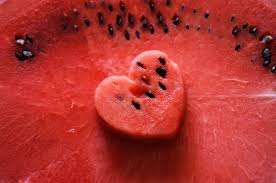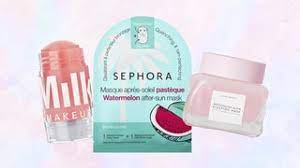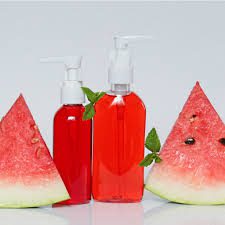Watermelon flesh refers to the edible, juicy, and pulpy part of a watermelon fruit. It is the vibrant, juicy, and sweet portion that lies beneath the tough green rind and white pith. The flesh of a watermelon is the main reason why it is such a popular and refreshing summer fruit.
Watermelon flesh is typically bright red or pink, although there are also varieties with yellow or orange flesh. The color may vary depending on the specific variety. The texture of watermelon flesh is smooth and succulent. It is soft and somewhat fibrous, but it is easy to bite into and chew. The flesh contains a high water content, which contributes to its refreshing quality.
Watermelon flesh is known for its sweet, juicy flavor. It has a distinct, refreshing taste that is often described as both sugary and subtly tangy. The sweetness can vary depending on the ripeness of the fruit.
Traditional watermelons have black seeds embedded within the flesh, which are typically removed before consumption. However, seedless varieties have become increasingly popular, and they are now more readily available in many markets. Seedless watermelon varieties produce small, white, and edible seeds that are less noticeable.
Watermelon flesh is low in calories and fat, making it a healthy and hydrating snack option. It is rich in vitamins A and C, as well as antioxidants like lycopene, which gives it the red color. Watermelon is also a good source of hydration due to its high water content.
Watermelon flesh is commonly enjoyed fresh, either sliced or diced, on its own or as part of fruit salads, smoothies, or refreshing beverages. Its sweet and juicy nature makes it a favorite during hot summer months, as it helps quench thirst and provides a cooling effect.
Economic Importance, Uses, and By-Products of Watermelon Flesh

Watermelon flesh, the juicy red part of the fruit, has several economic importance and uses. Let’s explore them along with examples:
1. Food Consumption: Watermelon flesh is primarily consumed as a refreshing and hydrating fruit. It has high water content, making it a popular choice for quenching thirst and combating dehydration, especially during hot summer months. Its sweet taste and crunchy texture make it a favorite snack for many people.
2. Culinary Uses: Watermelon flesh is versatile and can be used in various culinary preparations. It can be eaten as is, used in fruit salads, smoothies, sorbets, and popsicles. Watermelon also pairs well with savory ingredients, such as feta cheese, mint, and balsamic vinegar, in salads and appetizers.
3. Nutritional Value: Watermelon flesh is a rich source of essential nutrients and vitamins, including vitamin C, vitamin A, potassium, and lycopene. These nutrients contribute to a healthy diet and support overall well-being.
4. Beverage Industry: Watermelon flesh is used in the production of juices, smoothies, and flavored water. It can be juiced or blended to create refreshing beverages with a naturally sweet taste. Watermelon-based drinks are popular in the beverage industry due to their flavor and health benefits.
5. Food Processing: Watermelon flesh is processed to make various products, such as jams, jellies, syrups, and candies. These processed forms offer longer shelf life and can be enjoyed throughout the year, even when fresh watermelons are not in season.
6. Cosmetics and Skincare: Watermelon flesh contains high levels of antioxidants and vitamins, making it beneficial for skincare. Extracts and oils derived from watermelon flesh are used in cosmetic products, such as moisturizers, face masks, and serums, to hydrate and nourish the skin.

7. Medicine and Nutraceuticals: Watermelon flesh contains citrulline, an amino acid that has potential health benefits. Citrulline is known to promote cardiovascular health and improve blood flow. It is also being researched for its potential use in treating conditions like hypertension and erectile dysfunction.
8. Animal Feed: Watermelon flesh can be utilized as a source of feed for livestock, particularly pigs and poultry. It provides hydration, nutrients, and palatability to the animals’ diet.
9. Agricultural Uses: Watermelon flesh, along with the rind, can be composted and used as organic fertilizer to enrich the soil. The nutrients present in the flesh contribute to the growth and development of plants, improving crop yield and quality.
10. Economic Trade: Watermelon flesh is a valuable agricultural commodity, and its production and trade contribute to the global economy. Many countries rely on watermelon cultivation as a significant source of income, generating revenue through domestic sales and exports.
11. Tourism and Hospitality: Watermelon is often associated with leisure and vacation, and its presence in hotels, resorts, and restaurants can attract tourists. Watermelon slices, juice, and desserts are commonly served in hospitality establishments, adding to the overall guest experience.
12. Seed Production: Watermelon seeds, found within the flesh, have economic value as well. They are used in the production of seedless watermelons, where specific breeding techniques are employed to remove the seeds. Seedless watermelons are popular among consumers, leading to demand for seeds adapted to their cultivation.
Read Also : Economic Importance, Uses, and By-Products of Watermelon Rind
13. Traditional and Cultural Practices: Watermelon holds cultural significance in many societies, and its consumption is associated with various festivals, ceremonies, and rituals. This cultural significance contributes to the economic value of watermelon and its role in preserving traditions.
14. Eco-Tourism: In some regions, watermelon farms and orchards attract eco-tourism, allowing visitors to explore agricultural practices, pick their own watermelons, and learn about the cultivation process. This form of tourism provides an additional income stream for farmers and promotes agricultural sustainability.
15. Job Creation: The cultivation, harvesting, processing, and distribution of watermelons provide employment opportunities for individuals across the supply chain. From farmers and laborers to processors, packagers, and marketers, the watermelon industry contributes to job creation and economic livelihoods.
16. Research and Development: Watermelon flesh is an important subject of research and development, particularly in the fields of agriculture, nutrition, and biotechnology. Scientists and researchers study its genetics, breeding techniques, nutritional composition, and potential health benefits, driving advancements and innovation within the industry.
17. Export and Import Trade: Watermelon flesh is traded globally, allowing countries to import and export the fruit to meet consumer demand. Some regions have favorable growing conditions for watermelons, while others rely on imports to supply their markets. International trade of watermelon flesh contributes to economic growth and international cooperation.
18. Waste Reduction: Utilizing watermelon flesh in various industries helps reduce food waste. By processing and transforming excess or imperfect watermelons into value-added products, such as juices, jams, and cosmetics, the economic value is extended while minimizing waste.
19. Food Preservation: Watermelon flesh can be preserved through dehydration or freezing. Dehydrated watermelon can be used in trail mixes, granola bars, or as a snack, while frozen watermelon can be used in smoothies and desserts. These preservation methods allow for the availability of watermelon year-round and contribute to the economy by extending its shelf life.
19. Event Catering and Celebrations: Watermelon flesh is often included in catering services for events, such as weddings, parties, and picnics. Its vibrant color, refreshing taste, and versatility make it an attractive option for serving large groups of people, contributing to the catering industry’s economic viability.
20. Juice Bars and Smoothie Shops: Watermelon flesh is a popular ingredient in juice bars and smoothie shops. Its naturally sweet and hydrating properties make it an excellent base for refreshing and healthy beverages. The demand for watermelon-based drinks in these establishments contributes to their profitability and economic sustainability.
21. Agricultural Exports and Trade: Countries that have favorable watermelon growing conditions can benefit from the export of watermelon flesh. These exports generate revenue and foreign exchange earnings, contributing to the overall economy and strengthening international trade relationships.
22. Seed Oil Production: Watermelon seeds can be pressed to extract oil, which has various applications in the food industry, cosmetics, and pharmaceuticals. Watermelon seed oil is known for its moisturizing and nourishing properties, making it a valuable ingredient in skincare and haircare products.
23. Animal Research and Feed Studies: Watermelon flesh is utilized in animal research and feed studies to evaluate its nutritional value, impact on animal health, and potential as a feed ingredient. These studies contribute to the advancement of animal nutrition and the development of balanced and sustainable animal feed formulations.
24. Watermelon Seed Consumption: Watermelon seeds are often consumed as a snack or used in culinary preparations. Roasted watermelon seeds are popular in many cultures and are enjoyed as a crunchy and nutritious snack.
25. Biofuel Production: Watermelon flesh, along with other fruit waste, can be used in biofuel production. The sugars and carbohydrates present in the flesh can be converted into bioethanol through fermentation, offering an alternative and renewable energy source.
26. Edible Art and Food Styling: Watermelon flesh’s vibrant color, unique shape, and refreshing appeal make it a popular ingredient for edible art and food styling. Skilled chefs and food artists carve, sculpt, and create intricate designs using watermelon flesh, attracting attention and contributing to the culinary arts industry.
These economic importance and uses of watermelon flesh highlight its versatility, commercial value, and potential applications in various sectors, further contributing to its economic significance.
The Products and By-products That Can Be Derived From Watermelon Flesh

Watermelon flesh is a versatile ingredient that can be used to create various products and by-products. Here are some examples:
Fresh-cut Watermelon: The flesh of watermelon can be sliced or cubed and sold as fresh-cut fruit. It is a popular snack or ingredient in fruit salads.
1. Watermelon Juice: Watermelon flesh can be juiced to create refreshing watermelon juice. This can be enjoyed on its own or used as a base for smoothies, cocktails, or other beverages.
2. Watermelon Pulp: After extracting the juice, the remaining pulp can be used in various ways. It can be added to smoothies, yogurt, or used as an ingredient in baked goods like cakes or muffins.
3. Watermelon Puree: Watermelon flesh can be blended into a smooth puree. This puree can be used as a base for sorbets, ice creams, popsicles, or sauces.
4. Watermelon Jam: Watermelon flesh, when cooked with sugar and lemon juice, can be made into a delicious jam. This can be spread on toast, used in pastries, or paired with cheese.
5. Watermelon Sorbet: Watermelon puree can be combined with sugar syrup and frozen to create a refreshing sorbet. It is a popular frozen dessert during the summer.
6. Watermelon Agua Fresca: Watermelon juice can be mixed with water, sugar, and lime juice to make a traditional Mexican beverage called “agua fresca.” It is a refreshing and hydrating drink.
7. Watermelon Rind Pickles: The rind of the watermelon can be pickled, creating a tangy and crunchy snack. This is a popular preservation method and a way to reduce waste.
8. Watermelon Seeds: Watermelon seeds can be dried and roasted, creating a nutritious and flavorful snack. They can be seasoned with salt or spices.
9. Watermelon Seed Oil: Watermelon seeds can also be cold-pressed to extract oil. This oil is used in cosmetics and skincare products due to its moisturizing properties.
10. Animal Feed: Watermelon flesh, rind, and seeds can be used as animal feed. They provide hydration, nutrients, and dietary fiber for livestock or poultry.
Read Also : Economic Importance, Uses, and By-Products of Watermelon Fruits
11. Compost: Watermelon scraps, including the rind and any leftovers, can be composted. They contribute to organic waste recycling and can be used as a natural fertilizer for plants.
12. Watermelon Extract: Watermelon flesh can be processed to extract specific compounds, such as lycopene or citrulline. These extracts are used in dietary supplements, functional foods, or as ingredients in skincare products.
13. Watermelon Face Masks: Watermelon flesh, when blended or combined with other natural ingredients, can be used to create hydrating and rejuvenating face masks. The high water content and antioxidants in watermelon help nourish the skin.
14. Watermelon Salsa: Diced watermelon flesh can be combined with other ingredients like onions, peppers, lime juice, and herbs to create a refreshing and tangy watermelon salsa. It can be used as a dip, topping for grilled meats, or a condiment.
15. Watermelon Infused Water: Watermelon flesh, along with other fruits, herbs, or even cucumber slices, can be added to water to create flavored infused water. This provides a subtle and refreshing taste to regular water.
16. Watermelon Wine: Watermelon flesh can be fermented and processed to create watermelon wine. It offers a unique fruity flavor and is a popular choice for homemade or artisanal winemaking.
17. Watermelon Vinegar: Watermelon juice or flesh can be fermented to create watermelon vinegar. It can be used in salad dressings, marinades, or as a condiment for enhancing flavors.
18. Watermelon Candy or Gummies: Watermelon puree or juice can be combined with sugar or other sweeteners and gelatin to create watermelon-flavored candy or gummies. These are popular treats enjoyed by both children and adults.
19. Watermelon Face Toner: Watermelon juice or extract can be combined with other ingredients to create a refreshing face toner. It helps hydrate and tone the skin, leaving it feeling revitalized.
20. Watermelon Smoothie Bowls: Watermelon flesh, when blended with other fruits, yogurt, or plant-based milk, can be used as a base for smoothie bowls. These bowls are often topped with various fruits, nuts, and seeds, creating a nutritious and Instagram-worthy breakfast or snack.
These are examples of the products and by-products that can be derived from watermelon flesh. The versatility of watermelon opens up numerous possibilities for culinary, skincare, and other applications.
Read Also : Strategies for Reducing Water Pollution
